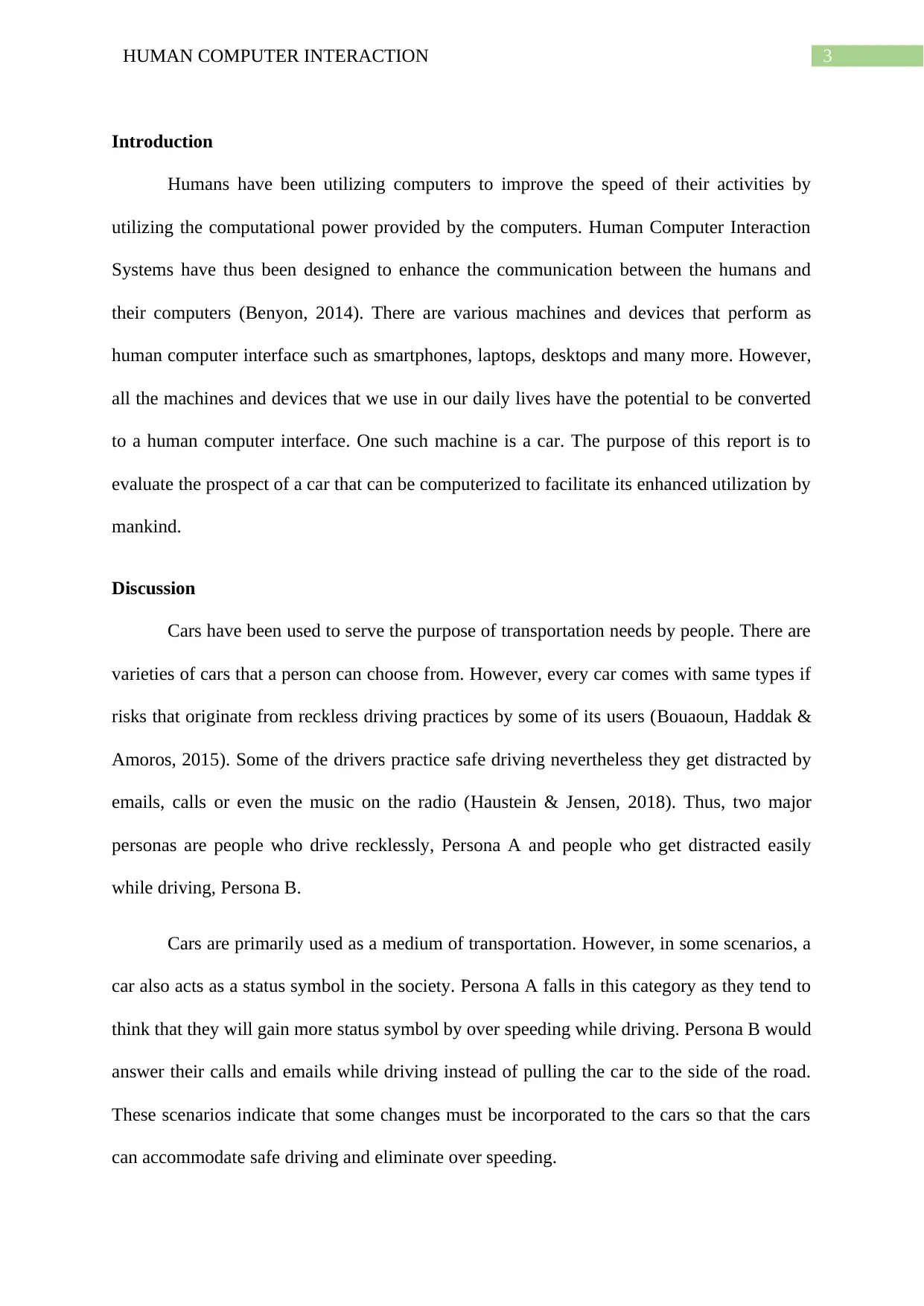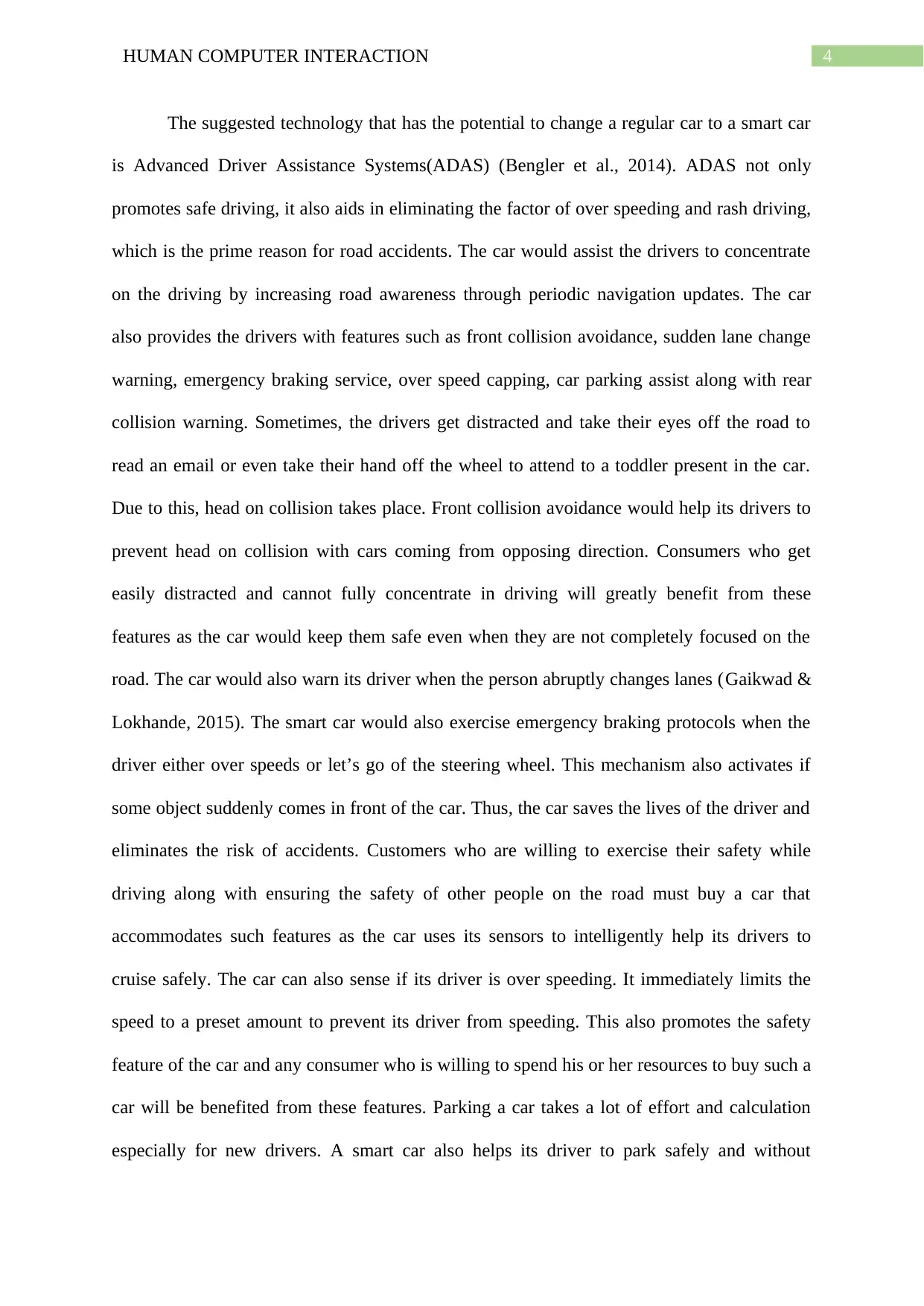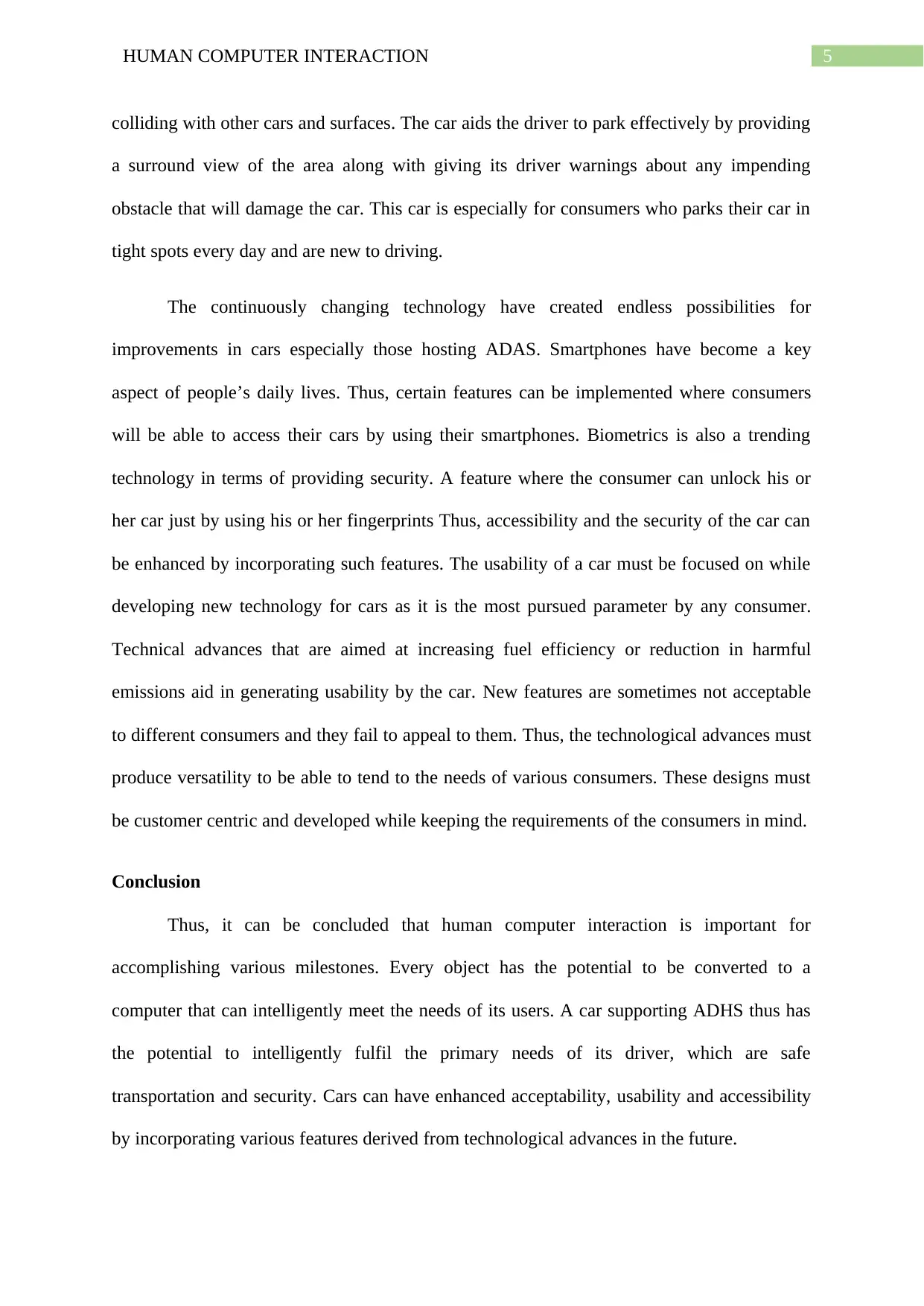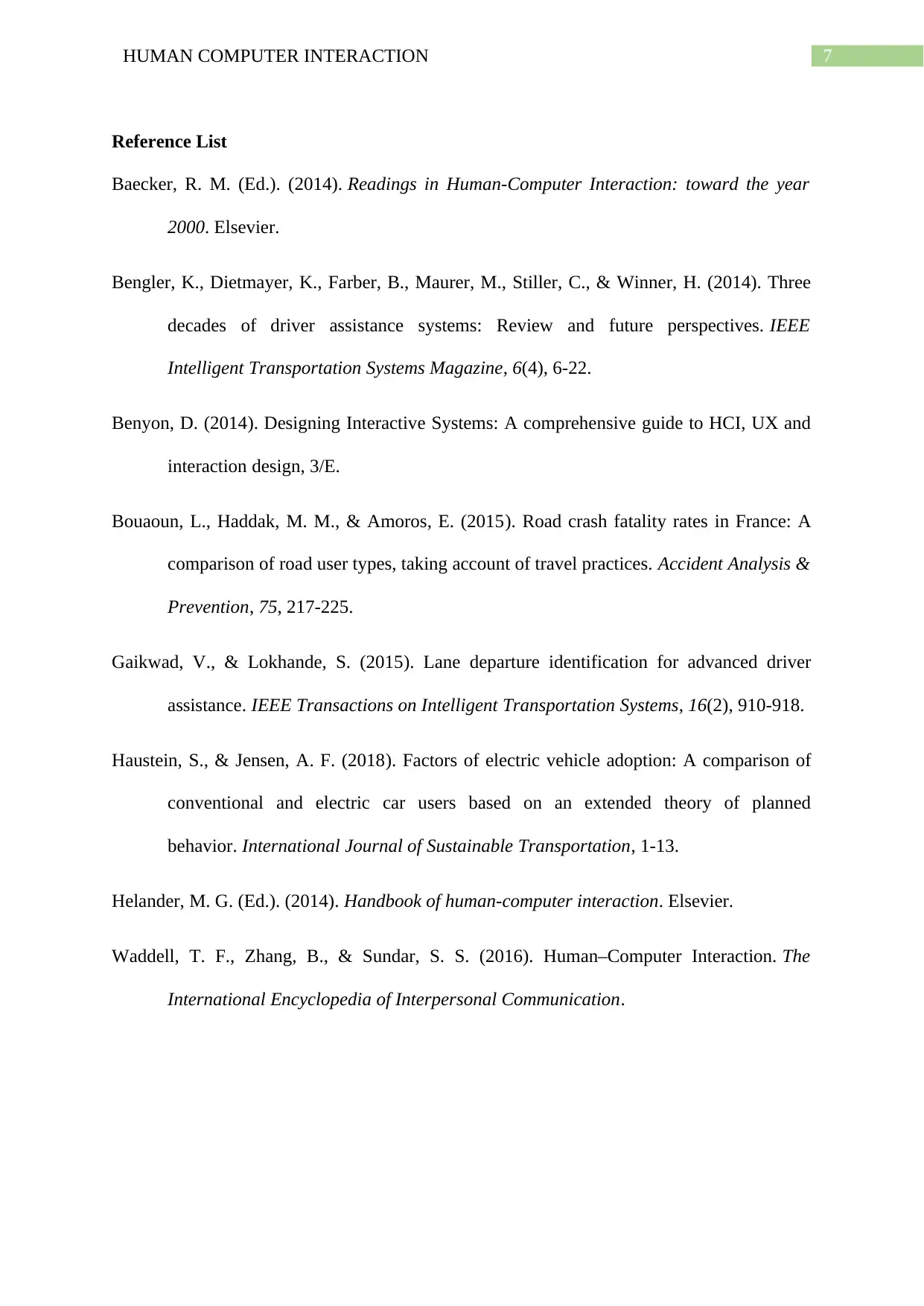Human Computer Interaction: A Car's Perspective
VerifiedAdded on 2021/04/21
|8
|1506
|53
AI Summary
The report discusses how a car can be converted into a smart car by incorporating ADAS, which promotes safe driving and eliminates over speeding. The car's sensors help drivers focus on the road, prevent head-on collisions, and exercise emergency braking protocols. Additionally, the car can sense if its driver is over speeding and limit the speed to a preset amount. The report also touches on accessibility and security features such as unlocking the car with fingerprints. Overall, the report concludes that human computer interaction in cars has the potential to enhance acceptability, usability, and accessibility.
Contribute Materials
Your contribution can guide someone’s learning journey. Share your
documents today.

Running head: HUMAN COMPUTER INTERACTION
Human Computer Interaction
Name of the Student
Name of the University
Author Note
Human Computer Interaction
Name of the Student
Name of the University
Author Note
Secure Best Marks with AI Grader
Need help grading? Try our AI Grader for instant feedback on your assignments.

1HUMAN COMPUTER INTERACTION
Executive Summary
Human Computer Interaction is one of the most popular research fields. The importance of
such an interaction will be discussed in this report by using a very common artifact, a car.
Interactions of consumers with their cars will also be discussed in this report. Finally, the
report will conclude by stating the technological advances in the future that will aid in
increasing the interaction capabilities of humans with computers.
Executive Summary
Human Computer Interaction is one of the most popular research fields. The importance of
such an interaction will be discussed in this report by using a very common artifact, a car.
Interactions of consumers with their cars will also be discussed in this report. Finally, the
report will conclude by stating the technological advances in the future that will aid in
increasing the interaction capabilities of humans with computers.

2HUMAN COMPUTER INTERACTION
Table of Contents
Introduction................................................................................................................................3
Discussion..................................................................................................................................3
Conclusion..................................................................................................................................5
Reference List............................................................................................................................6
Table of Contents
Introduction................................................................................................................................3
Discussion..................................................................................................................................3
Conclusion..................................................................................................................................5
Reference List............................................................................................................................6

3HUMAN COMPUTER INTERACTION
Introduction
Humans have been utilizing computers to improve the speed of their activities by
utilizing the computational power provided by the computers. Human Computer Interaction
Systems have thus been designed to enhance the communication between the humans and
their computers (Benyon, 2014). There are various machines and devices that perform as
human computer interface such as smartphones, laptops, desktops and many more. However,
all the machines and devices that we use in our daily lives have the potential to be converted
to a human computer interface. One such machine is a car. The purpose of this report is to
evaluate the prospect of a car that can be computerized to facilitate its enhanced utilization by
mankind.
Discussion
Cars have been used to serve the purpose of transportation needs by people. There are
varieties of cars that a person can choose from. However, every car comes with same types if
risks that originate from reckless driving practices by some of its users (Bouaoun, Haddak &
Amoros, 2015). Some of the drivers practice safe driving nevertheless they get distracted by
emails, calls or even the music on the radio (Haustein & Jensen, 2018). Thus, two major
personas are people who drive recklessly, Persona A and people who get distracted easily
while driving, Persona B.
Cars are primarily used as a medium of transportation. However, in some scenarios, a
car also acts as a status symbol in the society. Persona A falls in this category as they tend to
think that they will gain more status symbol by over speeding while driving. Persona B would
answer their calls and emails while driving instead of pulling the car to the side of the road.
These scenarios indicate that some changes must be incorporated to the cars so that the cars
can accommodate safe driving and eliminate over speeding.
Introduction
Humans have been utilizing computers to improve the speed of their activities by
utilizing the computational power provided by the computers. Human Computer Interaction
Systems have thus been designed to enhance the communication between the humans and
their computers (Benyon, 2014). There are various machines and devices that perform as
human computer interface such as smartphones, laptops, desktops and many more. However,
all the machines and devices that we use in our daily lives have the potential to be converted
to a human computer interface. One such machine is a car. The purpose of this report is to
evaluate the prospect of a car that can be computerized to facilitate its enhanced utilization by
mankind.
Discussion
Cars have been used to serve the purpose of transportation needs by people. There are
varieties of cars that a person can choose from. However, every car comes with same types if
risks that originate from reckless driving practices by some of its users (Bouaoun, Haddak &
Amoros, 2015). Some of the drivers practice safe driving nevertheless they get distracted by
emails, calls or even the music on the radio (Haustein & Jensen, 2018). Thus, two major
personas are people who drive recklessly, Persona A and people who get distracted easily
while driving, Persona B.
Cars are primarily used as a medium of transportation. However, in some scenarios, a
car also acts as a status symbol in the society. Persona A falls in this category as they tend to
think that they will gain more status symbol by over speeding while driving. Persona B would
answer their calls and emails while driving instead of pulling the car to the side of the road.
These scenarios indicate that some changes must be incorporated to the cars so that the cars
can accommodate safe driving and eliminate over speeding.
Secure Best Marks with AI Grader
Need help grading? Try our AI Grader for instant feedback on your assignments.

4HUMAN COMPUTER INTERACTION
The suggested technology that has the potential to change a regular car to a smart car
is Advanced Driver Assistance Systems(ADAS) (Bengler et al., 2014). ADAS not only
promotes safe driving, it also aids in eliminating the factor of over speeding and rash driving,
which is the prime reason for road accidents. The car would assist the drivers to concentrate
on the driving by increasing road awareness through periodic navigation updates. The car
also provides the drivers with features such as front collision avoidance, sudden lane change
warning, emergency braking service, over speed capping, car parking assist along with rear
collision warning. Sometimes, the drivers get distracted and take their eyes off the road to
read an email or even take their hand off the wheel to attend to a toddler present in the car.
Due to this, head on collision takes place. Front collision avoidance would help its drivers to
prevent head on collision with cars coming from opposing direction. Consumers who get
easily distracted and cannot fully concentrate in driving will greatly benefit from these
features as the car would keep them safe even when they are not completely focused on the
road. The car would also warn its driver when the person abruptly changes lanes (Gaikwad &
Lokhande, 2015). The smart car would also exercise emergency braking protocols when the
driver either over speeds or let’s go of the steering wheel. This mechanism also activates if
some object suddenly comes in front of the car. Thus, the car saves the lives of the driver and
eliminates the risk of accidents. Customers who are willing to exercise their safety while
driving along with ensuring the safety of other people on the road must buy a car that
accommodates such features as the car uses its sensors to intelligently help its drivers to
cruise safely. The car can also sense if its driver is over speeding. It immediately limits the
speed to a preset amount to prevent its driver from speeding. This also promotes the safety
feature of the car and any consumer who is willing to spend his or her resources to buy such a
car will be benefited from these features. Parking a car takes a lot of effort and calculation
especially for new drivers. A smart car also helps its driver to park safely and without
The suggested technology that has the potential to change a regular car to a smart car
is Advanced Driver Assistance Systems(ADAS) (Bengler et al., 2014). ADAS not only
promotes safe driving, it also aids in eliminating the factor of over speeding and rash driving,
which is the prime reason for road accidents. The car would assist the drivers to concentrate
on the driving by increasing road awareness through periodic navigation updates. The car
also provides the drivers with features such as front collision avoidance, sudden lane change
warning, emergency braking service, over speed capping, car parking assist along with rear
collision warning. Sometimes, the drivers get distracted and take their eyes off the road to
read an email or even take their hand off the wheel to attend to a toddler present in the car.
Due to this, head on collision takes place. Front collision avoidance would help its drivers to
prevent head on collision with cars coming from opposing direction. Consumers who get
easily distracted and cannot fully concentrate in driving will greatly benefit from these
features as the car would keep them safe even when they are not completely focused on the
road. The car would also warn its driver when the person abruptly changes lanes (Gaikwad &
Lokhande, 2015). The smart car would also exercise emergency braking protocols when the
driver either over speeds or let’s go of the steering wheel. This mechanism also activates if
some object suddenly comes in front of the car. Thus, the car saves the lives of the driver and
eliminates the risk of accidents. Customers who are willing to exercise their safety while
driving along with ensuring the safety of other people on the road must buy a car that
accommodates such features as the car uses its sensors to intelligently help its drivers to
cruise safely. The car can also sense if its driver is over speeding. It immediately limits the
speed to a preset amount to prevent its driver from speeding. This also promotes the safety
feature of the car and any consumer who is willing to spend his or her resources to buy such a
car will be benefited from these features. Parking a car takes a lot of effort and calculation
especially for new drivers. A smart car also helps its driver to park safely and without

5HUMAN COMPUTER INTERACTION
colliding with other cars and surfaces. The car aids the driver to park effectively by providing
a surround view of the area along with giving its driver warnings about any impending
obstacle that will damage the car. This car is especially for consumers who parks their car in
tight spots every day and are new to driving.
The continuously changing technology have created endless possibilities for
improvements in cars especially those hosting ADAS. Smartphones have become a key
aspect of people’s daily lives. Thus, certain features can be implemented where consumers
will be able to access their cars by using their smartphones. Biometrics is also a trending
technology in terms of providing security. A feature where the consumer can unlock his or
her car just by using his or her fingerprints Thus, accessibility and the security of the car can
be enhanced by incorporating such features. The usability of a car must be focused on while
developing new technology for cars as it is the most pursued parameter by any consumer.
Technical advances that are aimed at increasing fuel efficiency or reduction in harmful
emissions aid in generating usability by the car. New features are sometimes not acceptable
to different consumers and they fail to appeal to them. Thus, the technological advances must
produce versatility to be able to tend to the needs of various consumers. These designs must
be customer centric and developed while keeping the requirements of the consumers in mind.
Conclusion
Thus, it can be concluded that human computer interaction is important for
accomplishing various milestones. Every object has the potential to be converted to a
computer that can intelligently meet the needs of its users. A car supporting ADHS thus has
the potential to intelligently fulfil the primary needs of its driver, which are safe
transportation and security. Cars can have enhanced acceptability, usability and accessibility
by incorporating various features derived from technological advances in the future.
colliding with other cars and surfaces. The car aids the driver to park effectively by providing
a surround view of the area along with giving its driver warnings about any impending
obstacle that will damage the car. This car is especially for consumers who parks their car in
tight spots every day and are new to driving.
The continuously changing technology have created endless possibilities for
improvements in cars especially those hosting ADAS. Smartphones have become a key
aspect of people’s daily lives. Thus, certain features can be implemented where consumers
will be able to access their cars by using their smartphones. Biometrics is also a trending
technology in terms of providing security. A feature where the consumer can unlock his or
her car just by using his or her fingerprints Thus, accessibility and the security of the car can
be enhanced by incorporating such features. The usability of a car must be focused on while
developing new technology for cars as it is the most pursued parameter by any consumer.
Technical advances that are aimed at increasing fuel efficiency or reduction in harmful
emissions aid in generating usability by the car. New features are sometimes not acceptable
to different consumers and they fail to appeal to them. Thus, the technological advances must
produce versatility to be able to tend to the needs of various consumers. These designs must
be customer centric and developed while keeping the requirements of the consumers in mind.
Conclusion
Thus, it can be concluded that human computer interaction is important for
accomplishing various milestones. Every object has the potential to be converted to a
computer that can intelligently meet the needs of its users. A car supporting ADHS thus has
the potential to intelligently fulfil the primary needs of its driver, which are safe
transportation and security. Cars can have enhanced acceptability, usability and accessibility
by incorporating various features derived from technological advances in the future.

6HUMAN COMPUTER INTERACTION
Paraphrase This Document
Need a fresh take? Get an instant paraphrase of this document with our AI Paraphraser

7HUMAN COMPUTER INTERACTION
Reference List
Baecker, R. M. (Ed.). (2014). Readings in Human-Computer Interaction: toward the year
2000. Elsevier.
Bengler, K., Dietmayer, K., Farber, B., Maurer, M., Stiller, C., & Winner, H. (2014). Three
decades of driver assistance systems: Review and future perspectives. IEEE
Intelligent Transportation Systems Magazine, 6(4), 6-22.
Benyon, D. (2014). Designing Interactive Systems: A comprehensive guide to HCI, UX and
interaction design, 3/E.
Bouaoun, L., Haddak, M. M., & Amoros, E. (2015). Road crash fatality rates in France: A
comparison of road user types, taking account of travel practices. Accident Analysis &
Prevention, 75, 217-225.
Gaikwad, V., & Lokhande, S. (2015). Lane departure identification for advanced driver
assistance. IEEE Transactions on Intelligent Transportation Systems, 16(2), 910-918.
Haustein, S., & Jensen, A. F. (2018). Factors of electric vehicle adoption: A comparison of
conventional and electric car users based on an extended theory of planned
behavior. International Journal of Sustainable Transportation, 1-13.
Helander, M. G. (Ed.). (2014). Handbook of human-computer interaction. Elsevier.
Waddell, T. F., Zhang, B., & Sundar, S. S. (2016). Human–Computer Interaction. The
International Encyclopedia of Interpersonal Communication.
Reference List
Baecker, R. M. (Ed.). (2014). Readings in Human-Computer Interaction: toward the year
2000. Elsevier.
Bengler, K., Dietmayer, K., Farber, B., Maurer, M., Stiller, C., & Winner, H. (2014). Three
decades of driver assistance systems: Review and future perspectives. IEEE
Intelligent Transportation Systems Magazine, 6(4), 6-22.
Benyon, D. (2014). Designing Interactive Systems: A comprehensive guide to HCI, UX and
interaction design, 3/E.
Bouaoun, L., Haddak, M. M., & Amoros, E. (2015). Road crash fatality rates in France: A
comparison of road user types, taking account of travel practices. Accident Analysis &
Prevention, 75, 217-225.
Gaikwad, V., & Lokhande, S. (2015). Lane departure identification for advanced driver
assistance. IEEE Transactions on Intelligent Transportation Systems, 16(2), 910-918.
Haustein, S., & Jensen, A. F. (2018). Factors of electric vehicle adoption: A comparison of
conventional and electric car users based on an extended theory of planned
behavior. International Journal of Sustainable Transportation, 1-13.
Helander, M. G. (Ed.). (2014). Handbook of human-computer interaction. Elsevier.
Waddell, T. F., Zhang, B., & Sundar, S. S. (2016). Human–Computer Interaction. The
International Encyclopedia of Interpersonal Communication.
1 out of 8
Related Documents
Your All-in-One AI-Powered Toolkit for Academic Success.
+13062052269
info@desklib.com
Available 24*7 on WhatsApp / Email
![[object Object]](/_next/static/media/star-bottom.7253800d.svg)
Unlock your academic potential
© 2024 | Zucol Services PVT LTD | All rights reserved.




